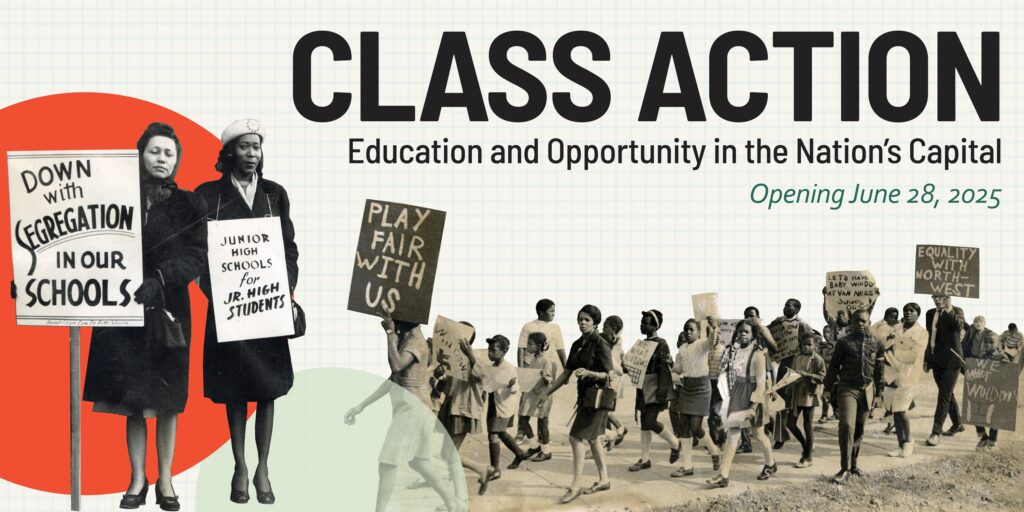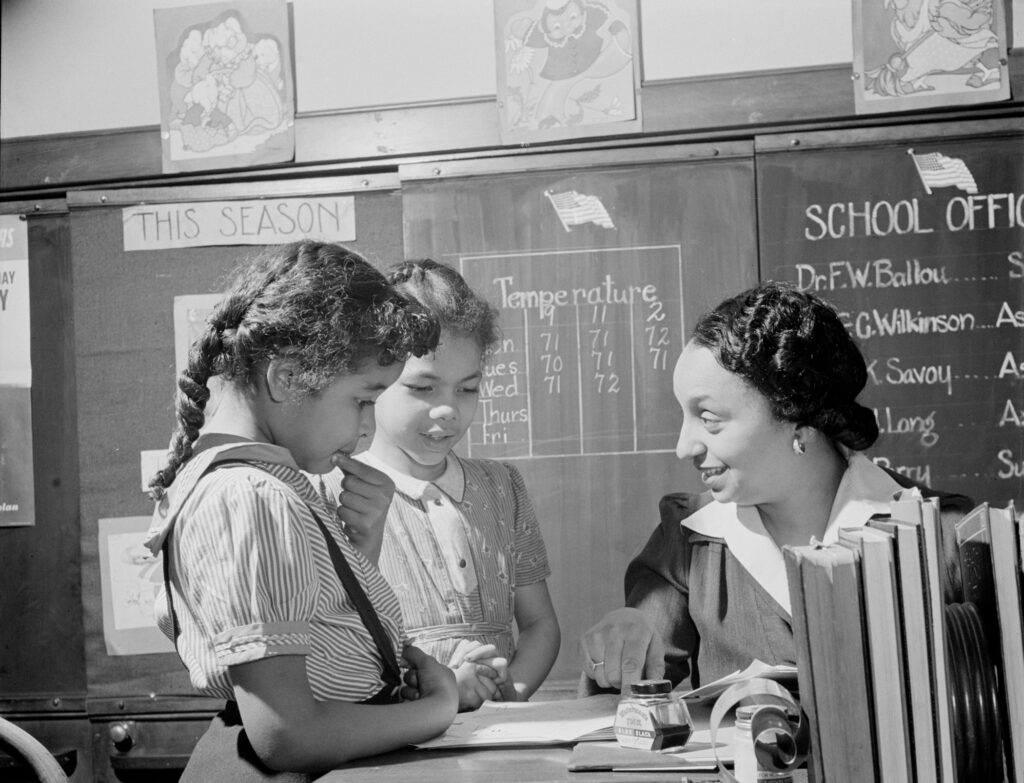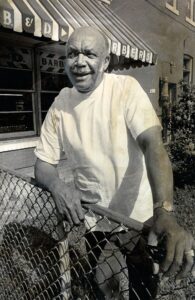
It’s almost here! The DC History Center’s new exhibit Class Action: Education and Opportunity in the Nation’s Capital opens to the public on Saturday, June 28. The family-friendly, interactive exhibition will showcase the ways in which DC parents, students, teachers, advocates, and activists have fought to ensure educational opportunities for Black children in the District for over two centuries. Class Action is curated by Historian Erica Sterling, who also serves as an Assistant Professor of History at the University of Virginia.
ABOUT THE EXHIBIT
The story of education in DC will be told through a variety of images, text, oral histories, and interactive elements. Families will find old-fashioned chalkboards, a library nook, a costume locker, and playful vintage furniture. School-related props will take adults down memory lane and introduce children to classroom staples from yesteryear.
Class Action spans the antebellum period to the 2000s, highlighting the creation of a segregated public school system for Black Washingtonians after Emancipation, a pivotal moment when Congress established a publicly funded school system for all. The result was two systems: one white and one Black. Discrimination prevented college-educated African Americans, many with multiple degrees, from obtaining careers in their chosen fields, so they came to DC and taught in the Black school system. Combined with Howard University’s prestige, which attracted Black students and scholars, and DC’s position as the nation’s capital, the city soon gained a national reputation for excellent Black schools in spite of segregation.

Black Washingtonians fought for equal education for a century, and the fight continued after the Supreme Court’s Bolling v. Sharpe landmark decision desegregated DC schools in 1954. The exhibition will also point out the ways in which structural issues in society affected resources, communities, and policies, and how parental activism was foundational to creating change that benefitted all students.
“The world we live in didn’t magically materialize. The neighborhoods we frequent, the schools we attend—many decisions accumulated over time to create the society we live in today,” says Class Action Curator Erica Sterling. “The history of DC offers a window into that reality and invites visitors, no matter where they’re from, into a shared experience of learning about the past to help inform how we imagine the future.”

Class Action will also shed light on important figures who led the way for education in DC. Examples include author, educator, sociologist and Black liberation activist Anna Julia Cooper; Gardner Bishop, a barber who became known for his championing of civil rights and equal schools; and Joyce Garrett, a music teacher and choir director who nurtured the artistic and academic aspirations of her students. (Read more about these figures below!)
“The exhibit explores hard history, and it invites hands-on exploration of what it means to grow up with the nation’s capital as your hometown,” says Laura Brower Hagood, Executive Director of the DC History Center. “From taking a selfie with a giant image of the John Phillip Sousa Junior High School Class of 1976, to trying on Elgin Baylor‘s high school basketball uniform, to learning about pivotal figures in local educational history whose impact reached across the country, we hope that Class Action sparks cross-generational conversations about how school experiences shape us all.”

VISITING THE EXHIBIT
Class Action will open in the West Gallery space and is the DC History Center’s first major exhibition since 2019. It will be on display through 2030. The exhibit will serve as an anchor for public programming, K-12 field trips, and professional development for teachers. The exhibit is free and open to the public. In its first weekend, the exhibit will be open to the public Saturday, June 28 from 2pm to 6pm. Members will have the opportunity for a special preview that morning from 11am to 2pm. Sunday’s hours are 12pm to 6pm. Following the opening, regular exhibit hours will be Thursday-Sunday from 12pm to 6pm.
THANK YOU TO OUR SPONSORS
Class Action: Education and Opportunity in the Nation’s Capital is made possible thanks to the District of Columbia Executive Office of the Mayor–Office of the Deputy Mayor for Planning and Economic Development; the Institute for Museum and Library Services; Events DC; the Kiplinger Family Foundation; and the Julie B. Koczela Exhibit Fund.
SELECT BIOS FROM CLASS ACTION

Anna Julia Cooper
Born into slavery, Anna Julia Cooper (1858-1964) was a teacher, writer, and activist. A graduate of Oberlin College with bachelor’s and master’s degrees in math, Cooper taught at M Street School, later known as Dunbar High School, in 1887. She became principal of M Street in 1902 and guided the school in preparing its students for higher education. Despite racist attacks by local officials who questioned her students’ abilities, Cooper sent several graduates to college and Ivy League universities. The school board let her go in 1906, but she later returned as a teacher. In 1925, Cooper became the fourth Black woman in the country to earn her PhD from the University of Paris, Sorbonne. She also worked with multiple civic organizations in DC, co-founding a social service agency for African Americans.

Gardner Bishop
![]()
![]()
![]() Frustrated with severe overcrowding at his daughter’s school, Browne Junior High School, local barbershop owner Gardner Bishop (1909-1992) felt compelled to act. He and other Browne parents sued the DC school board and staged a six week long boycott, refusing to send their children to school in an act of protest in 1947. Bishop and the newly organized Consolidated Parents Group also launched the “Central for Cardozo” campaign, successfully replacing the extremely overcrowded, all-Black Cardozo High School with Central High School, a modern building built for white students that was under enrolled. A few years later, the parents’ ongoing activism paved the way to the Supreme Court decision Bolling v. Sharpe, which outlawed school segregation in DC.
Frustrated with severe overcrowding at his daughter’s school, Browne Junior High School, local barbershop owner Gardner Bishop (1909-1992) felt compelled to act. He and other Browne parents sued the DC school board and staged a six week long boycott, refusing to send their children to school in an act of protest in 1947. Bishop and the newly organized Consolidated Parents Group also launched the “Central for Cardozo” campaign, successfully replacing the extremely overcrowded, all-Black Cardozo High School with Central High School, a modern building built for white students that was under enrolled. A few years later, the parents’ ongoing activism paved the way to the Supreme Court decision Bolling v. Sharpe, which outlawed school segregation in DC.
Joyce Garrett
For thirty years, Joyce Garrett directed the Eastern High School choir. A graduate of Bennett College in North Carolina and Catholic University in DC, she began teaching at Eastern in 1972 after spending five years at Langley Junior High. Under her tutelage, the choir garnered a national and international reputation for excellence. In 1987, the International Youth and Music Festival invited the choir to compete in its prestigious competition in Vienna, Austria the following year. Garrett and her students spent months rehearsing and with the community’s help, raised more than $160,000 for their trip to Europe. Eastern High, the competition’s first all Black choir, won second place. Garrett’s musical expertise extended to the United States Naval Academy Gospel Choir and Alfred Street Baptist Church in Alexandria, and she also founded the Washington Youth Choir.